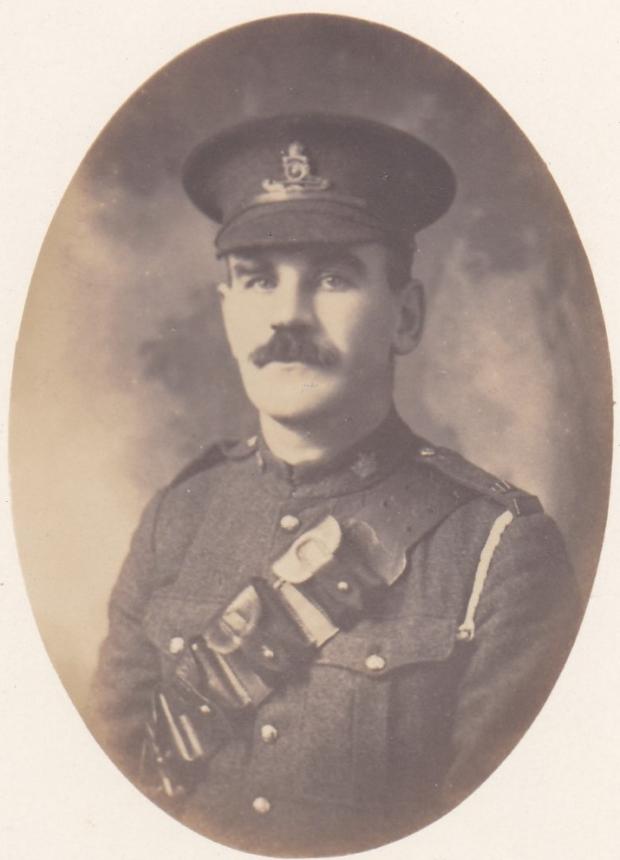Gnr
William Palliser Bruford
Information about birth
|
Date of birth: 27/03/1880 |
|
Place of birth: Taunton, Somerset, England, United Kingdom |
General information
|
Last known residence: 217 Cordova Street, Vancouver, British Columbia, Canada |
|
Profession: Freightman |
Army information
|
Country: Canada |
|
Force: Canadian Expeditionary Force |
|
Rank: Gunner |
|
Service number: 339462 |
|
Enlistment date: 09/12/1916 |
|
Enlistment place: Vancouver, British Columbia, Canada |
|
Units: — Canadian Field Artillery, 21st (Howitzer) Bty. 4th Bde. (Last known unit) |
Information about death
|
Date of death: 24/10/1917 |
|
Place of death: Zonnebeke Church - Zonnebeke Kirche, Belgium |
|
Cause of death: Killed in action (K.I.A.) |
|
Age: 37 |
Cemetery
|
White House Cemetery Plot: III Row: K Grave: 25 |
Distinctions and medals 2
|
British War Medal Medal |
|
Victory Medal Medal |
Points of interest 4
| #1 | Place of birth | ||
| #2 | Last known residence | ||
| #3 | Enlistment place | ||
| #4 | Place of death (approximate) |
My story
William Palliser Bruford, a former freight man, was born on 27 March 1880 in Taunton, Somerset, England. He was the son of Robert and Elizabeth Coles Labey and grew up at Nerrols Farm, Cheddon Fitzpaine, Somerset. William married Hilda May Labey in 1904 at West Monkton and became the father of three daughters. Before the war, the family emigrated to Canada, living at 217 Cordova Street, Vancouver, British Columbia. On 9 December 1916 William enlisted in Vancouver. He served as a Gunner in the 21st (Howitzer) Battery, of 4th Canadian Field Artillery Brigade, 2nd Canadian Division. While serving in Europe, the Bruford family returned to live with the family of his wife Elizabeth in La Rocque, Jersey, Channel Islands.
By late October 1917 the Battle of Passchendaele had entered its final phase. From 16 October 1917 onwards Canadian and British artillerists were positioned in Zonnebeke to prepare for the Cannadian attack on the ruins of Passchendaele. On October 25, the 21st Battery is positioned behind the ruins of Zonnebeke Church. On several occasions, the batteries of the 4th Brigade were heavily shelled. Several artillerists of this battery were killed because of this shelling.
William Palliser, aged 37, was killed in action on October 24, 1917. Gunner Bruford was initially buried where he fell, near Zonnebeke Church (28.D.28.a.10.70). On 25 July 1919 his remains were exhumed and reinterred in the White House Cemetery, Plot III, Row K, Grave 25.
William Palliser Bruford is mentioned on the grave of his wife and youngest daughter at La Croix Cemetery, Grouville, Jersey. His youngest daughter died on 9 August 2010, Aged 101 years.
In early 2019 “The Somerset Wood” was planted on the site of the old Nerrols Farm. The wood commemorates the county’s fallen from World War 1. It contains 11,281 trees, one for each of war dead listed on the in the Wells Cathedral memorial list. Although not mentioned in the list, William Palliser Bruford has been dubbed the “the face of the Somerset Wood”, since he is the only person from the parish killed in the war.
By late October 1917 the Battle of Passchendaele had entered its final phase. From 16 October 1917 onwards Canadian and British artillerists were positioned in Zonnebeke to prepare for the Cannadian attack on the ruins of Passchendaele. On October 25, the 21st Battery is positioned behind the ruins of Zonnebeke Church. On several occasions, the batteries of the 4th Brigade were heavily shelled. Several artillerists of this battery were killed because of this shelling.
William Palliser, aged 37, was killed in action on October 24, 1917. Gunner Bruford was initially buried where he fell, near Zonnebeke Church (28.D.28.a.10.70). On 25 July 1919 his remains were exhumed and reinterred in the White House Cemetery, Plot III, Row K, Grave 25.
William Palliser Bruford is mentioned on the grave of his wife and youngest daughter at La Croix Cemetery, Grouville, Jersey. His youngest daughter died on 9 August 2010, Aged 101 years.
In early 2019 “The Somerset Wood” was planted on the site of the old Nerrols Farm. The wood commemorates the county’s fallen from World War 1. It contains 11,281 trees, one for each of war dead listed on the in the Wells Cathedral memorial list. Although not mentioned in the list, William Palliser Bruford has been dubbed the “the face of the Somerset Wood”, since he is the only person from the parish killed in the war.
Sources 3
|
4th Bde Canadian Field Artillery (Library and Archives Canada, Ottawa (LAC), RG9-III-D-3, Volume number: 4967, Microfilm reel number: T-10789, File number: 537.) https://www.bac-lac.gc.ca/ Sources used |
|
Hill, Phil. Search for relatives of the fallen soldier chosen as the face of The Somerset Wood (Somerset County Gazette, 05.12.2020). https://www.somersetcountygazette.co.uk/news/18919198.search-relatives-fallen-soldier-chosen-face-somerset-wood/ Sources used |
|
Hill, Phil. William Palliser Bruford, the face of the Somerset Wood (Somerset County Gazette, 02.11.2021). https://www.somersetcountygazette.co.uk/news/19686630.william-palliser-bruford-face-somerset-wood/ Sources used |
More information 4
|
Commonwealth War Graves Commission Database https://www.cwgc.org/find-records/find-war-dead/casualty-details/454393 |
|
Lives of the First World War (Imperial War Museum) https://livesofthefirstworldwar.iwm.org.uk/lifestory/5489235 |
|
Namenlijst (In Flanders Fields Museum) https://namenlijst.org/publicsearch/#/person/_id=4cb2df3d-98b7-4a4d-a651-275a93919259 |
|
The Canadian Virtual War Memorial https://www.veterans.gc.ca/eng/remembrance/memorials/canadian-virtual-war-memorial/detail/454393 |
